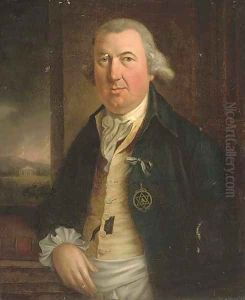Charles Wilson Peale Paintings
Charles Wilson Peale was an American painter, soldier, scientist, inventor, politician, and naturalist known for his portraits of leading figures of the American Revolution. He was born on April 15, 1741, in Chester, Queen Anne's County, Maryland to Charles Peale and Margaret Triggs. His early education was informal, and he began his career as a saddle maker, like his father. However, his interests and talents would soon lead him to pursue a career in art.
He began his artistic training under the guidance of John Hesselius and later moved to Boston to study with the influential American portraitist John Singleton Copley. Peale's artistic career was bolstered when he traveled to London in 1767 to study under American-born painter Benjamin West, who was then gaining fame in England. This experience profoundly shaped Peale's artistic style and technique.
Returning to America, Peale settled in Philadelphia, which was becoming a cultural and political center of the nascent United States. He quickly became one of the era's premier portraitists. Peale painted many of the notable figures of the American Revolution, including George Washington, whom he painted several times. Peale's portraits are known for their realism and attention to detail, which was part of the broader trend of Enlightenment emphasis on empiricism and the natural world.
In addition to his artistic work, Peale had a broad array of interests and contributed significantly to the American Enlightenment. He established the Philadelphia Museum, later known as Peale's American Museum, which was one of the earliest museums in the United States. It showcased not only art but also natural history exhibits, including specimens Peale himself collected. His interest in natural history also led him to participate in excavations of prehistoric bones, and he was one of the first to display a mastodon skeleton.
Peale's contributions extended to other realms as well. During the American Revolutionary War, he served as a captain in the Pennsylvania militia and participated in several key battles. He also dabbled in politics, serving in the Pennsylvania state assembly for a time.
Peale was a prolific artist, and his legacy includes not only his own extensive body of work but also the training of his many children, several of whom, such as Rembrandt Peale and Raphaelle Peale, became notable artists in their own right. His life reflects the multi-disciplinary interests of the Enlightenment and the American spirit of innovation and curiosity.
Charles Wilson Peale passed away on February 22, 1827, in Philadelphia, Pennsylvania, leaving behind a rich legacy as a foundational figure in American art and science.
